FABRIC VS PORTRAIT
I got a gorgeous book for Christmas:
"Merchants, princes and painters. Silk fabrics in Italian and Northers paintings 1300-1550", by Lisa Monnas (2008)
The book is very interesting reading, because it focuses on the fabrics in portrait outfits; what they meant to the people of the era, eventual symbolism, price, and authenticy. The book is extremely well researched, and it's amazing to see how the author has managed to match period fabric pieces to paintings. I promised to show some examples of that, and here goes:
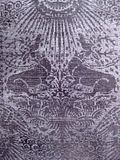
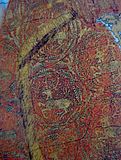
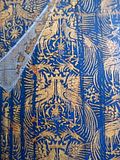
1. Lampas silk with symmetrical animal depictions and sunrays. There's lots of these in the book, the two painted examples overneath are from the "Richard II" part of the Wilton Diptych from 1396-99 in London (National Gallery).
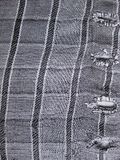
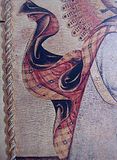
2. Checquered silk; the actual fabric is a sleeve-end lining from the late fourteenth century (V&A, London). The painted example is from a triptych by Simone Martini and Lippo Memmi, dated 1333 (Uffizi, Florence)
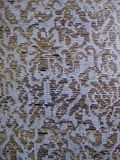
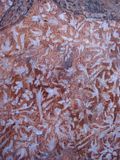
3. Brocaded Tartar silk; the authentic example from a dalmatic allegedly belonging to Benedict XI, early fourteenth century, while the painted example is from Simone Martini's "Maestà" from Palazzo Pubblico in Siena.

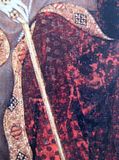
4. Crimson velvet with gold disks; the actual fabric is from the late thirteenth century and is in a private collection, while the painting is by Simone Martini, showing St Louis of Toulouse crowning Robert of Anjou", ca. 1317 (Museo di Capodimonte, Naples)
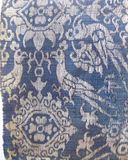
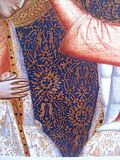
5. Lampas silk with birds and palmettes, from the fourteenth century. The fabric is from V&A in London. The painting is by Jacopo di Cione (and possibly Niccolò di Tommaso), showing the Coronation of the Virgin, ca. 1370.
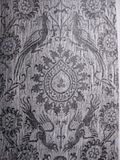
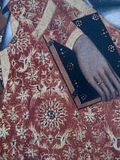
6. Lampas silk with palmettes and birds, second half of the fourteenth century (V&A, London). Painting by Giovanni del Biondo, showing St. Catherine of Alexandria with a donor, ca. 1407 (Duomo, Florence).
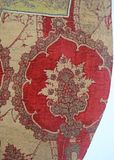
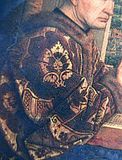
7. The Warwick chasuble, made of Italian brocaded velvet, after 1434 (V&A, London). Painting by Jan van Eyck, showing Virgin and Chancellor Rolin (Louvre, Paris).
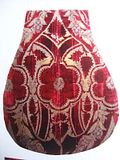
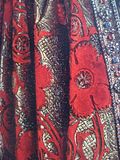
8. From a chasuble with large dianthus flowers, Italian ca. 1425-50 (Keir Collection, London). Painting is by Jan van Eyck, Annunciation i a Church, from 1434-36 (NGA, Washington)
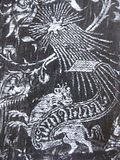
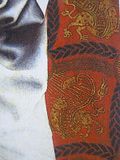
9. Italian lampas silk showing a beast with a scroll, from the fourteenth century (Ôsterreichischen Museum, Vienna) and Robert Campin's Standing Virgin and Child (Städel Museum, Frankfurt)
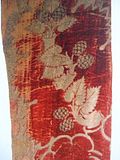
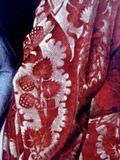
10. Crimson pile-on-pile velvet, with strawberries and leafs, Italian, from the second quarter of the fifteenth century (Musée Royale, Brussels). Painting by Rogier van der Weyden, the so-called St. Columba altarpiece, 1455 (Alte Pinakothek, Munich)
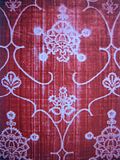
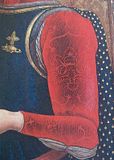
11. Italian crimson voided velvet, second half of the fifteenth century (V&A, London) and Carlo Crivelli's St. George, 1473 (Cathedral of Ascoli)
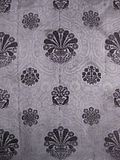
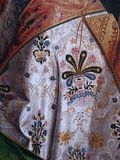
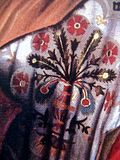
12. Lots of examples of this fabric in the book too. Seems to have been popular and/or common, although the two examples underneath are from the same painter. The examples above are 1. an Italian white damask brocaded in coloured silks (The Met, New York), 2. Marco Marziale's Supper at Emmaeus (1506, Accademia, Venice) and 3. Marco Marziale's The Circumcision (1500, National Gallery, London)


13. Late fifteenth century satin damask, Italian (V&A, London) and Giovanni Bellini's Doge Leonardo Loredan from 1501-04 (National Gallery, London)
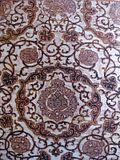
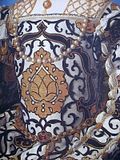
14. My favourite example... A Florentine velvet from the 1540's (Museo Civico, Turin) compared to Bronzino's portrait of Eleonora di Toledo from 1545 (Uffizi, Florence). I think these were first matched together by the authors of Moda a Firenze, at least Lisa Monnas credit them. The central motif is a pomegranate, a symbol of fertility.
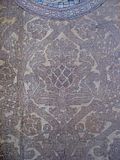
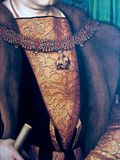
15. Part of a cope made of (probably) Florentine velvet, second quarter of the sixteenth century (Museo Diocesano, Gubbio), and Hans Holbein's portrait of Sir Henry Guildford ca. 1527 (Royal Collection, London)
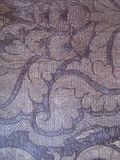
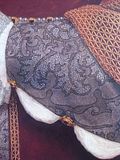
16. Cloth of purple and gold tissue with silver-gilt filé brocading, Florentine, 1520's-1530's (Merchant Taylor's Company, London). Hans Holbein's Portrait of Jane Seymour, 1536-37 (Kunsthistorisches Museum, Vienna)
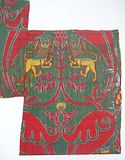

17. Lampas, probably Spanish, tabby pattern on silk ground (Courtauld Institute of Art, London) and Giovanni Bellini's Lamentation, ca. 1516 (Accademia, Venice)
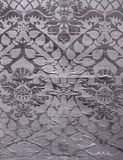
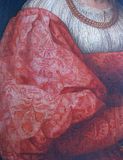
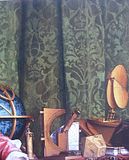
18. The "Medici" silk damask, with a diamond ring and (often) a pear motif. The fabric was probably not specific to the Medici family, as the diamond ring was the device of several prominent Italian families. The ambiguity of the symbols made it a versatile fabric. It has been found in many different contexts, for example in Pontormo's "Lady with a basket" and Holbein's "The Ambassadors". But it was also used by the Medicis, for example in Don Garcia's cape (now in Palazzo Pitti).
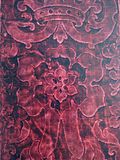
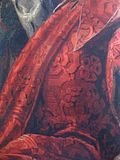
19. An "alto e basso" velvet of rich red colour, Venice, second quarter of the sixteenth century (V&A, London). Such fabric occurs in many 16th century Venetian paintings, by Tiziano and Veronese to mention some. The example here is from Veronese's Epiphany, 1573 (National Gallery, London)
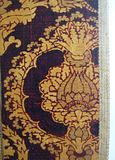
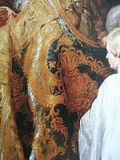
20. Another take on the 16th century pomegranate, here from a chasuble in a two-pile-height velvet. Italian, probably early sixteenth century (Rijksmuseum, Utrecht). There exists two versions of the painting; one is by Rubens and van Dyck, one is solely by van Dyck. The latter has another fabric in St. Ambrosio's cope. The one above is the collaboration version from ca. 1616 (Kunsthistorisches Museum, Vienna)
"Merchants, princes and painters. Silk fabrics in Italian and Northers paintings 1300-1550", by Lisa Monnas (2008)
The book is very interesting reading, because it focuses on the fabrics in portrait outfits; what they meant to the people of the era, eventual symbolism, price, and authenticy. The book is extremely well researched, and it's amazing to see how the author has managed to match period fabric pieces to paintings. I promised to show some examples of that, and here goes:



1. Lampas silk with symmetrical animal depictions and sunrays. There's lots of these in the book, the two painted examples overneath are from the "Richard II" part of the Wilton Diptych from 1396-99 in London (National Gallery).


2. Checquered silk; the actual fabric is a sleeve-end lining from the late fourteenth century (V&A, London). The painted example is from a triptych by Simone Martini and Lippo Memmi, dated 1333 (Uffizi, Florence)


3. Brocaded Tartar silk; the authentic example from a dalmatic allegedly belonging to Benedict XI, early fourteenth century, while the painted example is from Simone Martini's "Maestà" from Palazzo Pubblico in Siena.


4. Crimson velvet with gold disks; the actual fabric is from the late thirteenth century and is in a private collection, while the painting is by Simone Martini, showing St Louis of Toulouse crowning Robert of Anjou", ca. 1317 (Museo di Capodimonte, Naples)


5. Lampas silk with birds and palmettes, from the fourteenth century. The fabric is from V&A in London. The painting is by Jacopo di Cione (and possibly Niccolò di Tommaso), showing the Coronation of the Virgin, ca. 1370.


6. Lampas silk with palmettes and birds, second half of the fourteenth century (V&A, London). Painting by Giovanni del Biondo, showing St. Catherine of Alexandria with a donor, ca. 1407 (Duomo, Florence).


7. The Warwick chasuble, made of Italian brocaded velvet, after 1434 (V&A, London). Painting by Jan van Eyck, showing Virgin and Chancellor Rolin (Louvre, Paris).


8. From a chasuble with large dianthus flowers, Italian ca. 1425-50 (Keir Collection, London). Painting is by Jan van Eyck, Annunciation i a Church, from 1434-36 (NGA, Washington)


9. Italian lampas silk showing a beast with a scroll, from the fourteenth century (Ôsterreichischen Museum, Vienna) and Robert Campin's Standing Virgin and Child (Städel Museum, Frankfurt)


10. Crimson pile-on-pile velvet, with strawberries and leafs, Italian, from the second quarter of the fifteenth century (Musée Royale, Brussels). Painting by Rogier van der Weyden, the so-called St. Columba altarpiece, 1455 (Alte Pinakothek, Munich)


11. Italian crimson voided velvet, second half of the fifteenth century (V&A, London) and Carlo Crivelli's St. George, 1473 (Cathedral of Ascoli)



12. Lots of examples of this fabric in the book too. Seems to have been popular and/or common, although the two examples underneath are from the same painter. The examples above are 1. an Italian white damask brocaded in coloured silks (The Met, New York), 2. Marco Marziale's Supper at Emmaeus (1506, Accademia, Venice) and 3. Marco Marziale's The Circumcision (1500, National Gallery, London)


13. Late fifteenth century satin damask, Italian (V&A, London) and Giovanni Bellini's Doge Leonardo Loredan from 1501-04 (National Gallery, London)


14. My favourite example... A Florentine velvet from the 1540's (Museo Civico, Turin) compared to Bronzino's portrait of Eleonora di Toledo from 1545 (Uffizi, Florence). I think these were first matched together by the authors of Moda a Firenze, at least Lisa Monnas credit them. The central motif is a pomegranate, a symbol of fertility.


15. Part of a cope made of (probably) Florentine velvet, second quarter of the sixteenth century (Museo Diocesano, Gubbio), and Hans Holbein's portrait of Sir Henry Guildford ca. 1527 (Royal Collection, London)


16. Cloth of purple and gold tissue with silver-gilt filé brocading, Florentine, 1520's-1530's (Merchant Taylor's Company, London). Hans Holbein's Portrait of Jane Seymour, 1536-37 (Kunsthistorisches Museum, Vienna)


17. Lampas, probably Spanish, tabby pattern on silk ground (Courtauld Institute of Art, London) and Giovanni Bellini's Lamentation, ca. 1516 (Accademia, Venice)



18. The "Medici" silk damask, with a diamond ring and (often) a pear motif. The fabric was probably not specific to the Medici family, as the diamond ring was the device of several prominent Italian families. The ambiguity of the symbols made it a versatile fabric. It has been found in many different contexts, for example in Pontormo's "Lady with a basket" and Holbein's "The Ambassadors". But it was also used by the Medicis, for example in Don Garcia's cape (now in Palazzo Pitti).


19. An "alto e basso" velvet of rich red colour, Venice, second quarter of the sixteenth century (V&A, London). Such fabric occurs in many 16th century Venetian paintings, by Tiziano and Veronese to mention some. The example here is from Veronese's Epiphany, 1573 (National Gallery, London)


20. Another take on the 16th century pomegranate, here from a chasuble in a two-pile-height velvet. Italian, probably early sixteenth century (Rijksmuseum, Utrecht). There exists two versions of the painting; one is by Rubens and van Dyck, one is solely by van Dyck. The latter has another fabric in St. Ambrosio's cope. The one above is the collaboration version from ca. 1616 (Kunsthistorisches Museum, Vienna)